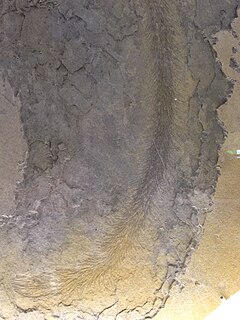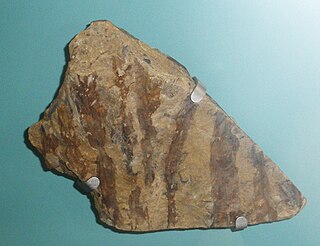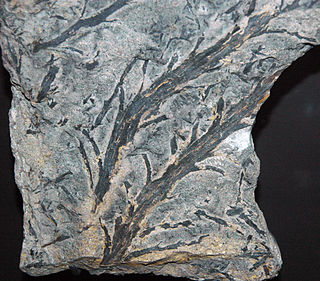
The lycophytes, when broadly circumscribed, are a vascular plant (tracheophyte) subgroup of the kingdom Plantae. They are sometimes placed in a division Lycopodiophyta or Lycophyta or in a subdivision Lycopodiophytina. They are one of the oldest lineages of extant (living) vascular plants; the group contains extinct plants that have been dated from the Silurian. Lycophytes were some of the dominating plant species of the Carboniferous period, and included tree-like species, although extant lycophytes are relatively small plants.

The zosterophylls are a group of extinct land plants that first appeared in the Silurian period. The taxon was first established by Banks in 1968 as the subdivision Zosterophyllophytina; they have since also been treated as the division Zosterophyllophyta or Zosterophyta and the class or plesion Zosterophyllopsida or Zosteropsida. They were among the first vascular plants in the fossil record, and had a world-wide distribution. They were probably stem-group lycophytes, forming a sister group to the ancestors of the living lycophytes. By the late Silurian a diverse assemblage of species existed, examples of which have been found fossilised in what is now Bathurst Island in Arctic Canada.

Baragwanathia is a genus of extinct lycopsid plants of Late Silurian to Early Devonian age, fossils of which have been found in Australia, Canada, China and Czechia. The name derives from William Baragwanath who discovered the first specimens of the type species, Baragwanathia longifolia, at Thomson River.

Drepanophycus is a genus of extinct plants of the division Lycopodiophyta of Early to Late Devonian age, found in Eastern Canada and Northeast US, China, Russia, Egypt and various parts of Northern Europe and Britain.

Psilophyton is a genus of extinct vascular plants. Described in 1859, it was one of the first fossil plants to be found which was of Devonian age. Specimens have been found in northern Maine, USA; Gaspé Bay, Quebec and New Brunswick, Canada; the Czech Republic; and Yunnan, China. Plants lacked leaves or true roots; spore-forming organs or sporangia were borne on the ends of branched clusters. It is significantly more complex than some other plants of comparable age and is thought to be part of the group from within which the modern ferns and seed plants evolved.

Leclercqia is a genus of early ligulate lycopsids (clubmosses), known as fossils from the Middle Devonian of Australia, North America, Germany, and Belgium. It has been placed in the Protolepidodendrales.

Polysporangiophytes, also called polysporangiates or formally Polysporangiophyta, are plants in which the spore-bearing generation (sporophyte) has branching stems (axes) that bear sporangia. The name literally means 'many sporangia plant'. The clade includes all land plants (embryophytes) except for the bryophytes whose sporophytes are normally unbranched, even if a few exceptional cases occur. While the definition is independent of the presence of vascular tissue, all living polysporangiophytes also have vascular tissue, i.e., are vascular plants or tracheophytes. Extinct polysporangiophytes are known that have no vascular tissue and so are not tracheophytes.

Aglaophyton major was the sporophyte generation of a diplohaplontic, pre-vascular, axial, free-sporing land plant of the Lower Devonian. It had anatomical features intermediate between those of the bryophytes and vascular plants or tracheophytes.
Sawdonia is an extinct genus of early vascular plants, known from the Upper Silurian to the Lower Carboniferous. Sawdonia is best recognized by the large number of spikes (enations) covering the plant. These are vascular plants that do not have vascular systems in their enations. The first species of this genus was described in 1859 by Sir J. William Dawson and, was originally attributed to the genus Psilophyton. He named this plant Psilophyton princeps. In 1971 Francis Hueber proposed a new genus for this species due to its "Divergent technical characters from the generic description for Psilophyton." The holotype used for description is Dawson Collection Number 48, pro parte, Museum Specimen Number 3243. Sir J. William Dawson Collection, Peter Redpath Museum, McGill University, Montreal, Quebec, Canada.

Pertica is a genus of extinct vascular plants of the Early to Middle Devonian. It has been placed in the "trimerophytes", a strongly paraphyletic group of early members of the lineage leading to modern ferns and seed plants.
The Exshaw Formation is a stratigraphic unit in the Western Canada Sedimentary Basin. It takes the name from the hamlet of Exshaw, Alberta in the Canadian Rockies, and was first described from outcrops on the banks of Jura Creek north of Exshaw by P.S. Warren in 1937. The formation is of Late Devonian to Early Mississippian age as determined by conodont biostratigraphy, and it straddles the Devonian-Carboniferous boundary.
The lowermost Upper Devonian fossil Pallaviciniites was for a time the oldest known liverwort until Metzgeriothallus was recovered from earlier Devonian strata.

Adoketophyton is a genus of extinct vascular plants of the Early Devonian. The plant was first described in 1977 based on fossil specimens from the Posongchong Formation, Wenshan district, Yunnan, China. These were originally named Zosterophyllum subverticillatum; later the species was transferred to a new genus as Adoketophyton subverticillatum. One cladistic analysis suggested that it is a lycophyte, related to the zosterophylls. Other researchers regard its placement within the vascular plants as uncertain.
Hsua is a genus of extinct vascular plants, known from the Devonian. The name of the genus honours the Chinese palaeobotanist, Jen Hsü.
The Campbellton Formation is a geologic formation in New Brunswick. It preserves fossils dating back to the latest Pragian and Emsian of the Devonian period.

Aneurophyton is a genus of extinct vascular plants that belong to the Aneurophytales, a class of progymnosperms. The genus is primarily known from records of two well-known species found in mostly Middle Devonian and Upper Devonian outcrops in Belgium, China, Germany, and the United States. Some uncertain species within the genus are also recorded from Middle Devonian outcrops in Kazakhstan, Russia, and the Ukraine. While a number of species have been described in the paleobotanical literature, the genus likely only contains two well-circumscribed species, A. germanicum and A. doui, and possibly a third species, A. olnense, from Fammenian outcrops in Belgium. If the ages of the Early Devonian (Emsian) records of A. germanicum reported from Siberia are confirmed, these would constitute the oldest records of this genus.
Armoricaphyton is an extinct monospecific genus of vascular land plants described from Early Devonian outcrops of the Chalonnes Formation in western France. The plant consists of small, leafless, longitudinally-ribbed axes that branch pseudomonopodially. Pairs of fusiform-shaped, twisted sporangia preserved as adpressions were found in association with the axes and may belong to this species. Permineralized specimens reveal the oldest documented wood or secondary xylem of any known fossil plant. The water-conducting tissues or tracheids consisted of extinct P-type cell walls. This type of cell wall consisted of scalariform bordered pits and perforated sheets that covered the openings (apertures) of the pits. A. chateaupannense is anatomically similar in some respects to other members of the Euphyllophytina such as Psilophyton and Franhueberia. Franhueberia gerriennei is also one of the earliest land plants described from the Early Devonian that was known to have wood. Given the differences between Armoricaphyton and these other genera and a lack of a complete understanding of the whole plant, Armoricaphyton is currently classified as Euphyllophytina incertae sedis.
Franhueberia is an extinct monospecific genus of vascular land plants described from Early Devonian outcrops of the Battery Point Formation along the south shore of Gaspé Bay, Quebec, Canada.
The geology of Ohio formed beginning more than one billion years ago in the Proterozoic eon of the Precambrian. The igneous and metamorphic crystalline basement rock is poorly understood except through deep boreholes and does not outcrop at the surface. The basement rock is divided between the Grenville Province and Superior Province. When the Grenville Province crust collided with Proto-North America, it launched the Grenville orogeny, a major mountain building event. The Grenville mountains eroded, filling in rift basins and Ohio was flooded and periodically exposed as dry land throughout the Paleozoic. In addition to marine carbonates such as limestone and dolomite, large deposits of shale and sandstone formed as subsequent mountain building events such as the Taconic orogeny and Acadian orogeny led to additional sediment deposition. Ohio transitioned to dryland conditions in the Pennsylvanian, forming large coal swamps and the region has been dryland ever since. Until the Pleistocene glaciations erased these features, the landscape was cut with deep stream valleys, which scoured away hundreds of meters of rock leaving little trace of geologic history in the Mesozoic and Cenozoic.

Chaleuria is a genus of extinct plants, found as fossils in New Brunswick, Canada. The rocks in which it was found are of Middle Devonian age. One species has been described, Chaleuria cirrosa. It was heterosporous, i.e. the spores were of two distinct sizes. Small spores (microspores) were in the size range 30–48 µm, large spores in the range 60–156 µm. Both kinds of spore were found in the same sporangium, although one size group tended to predominate in each sporangium. The original describers "tentatively" regarded the genus as a primitive member of the progymnosperms. In 2013, Hao and Xue listed the genus as a progymnosperm.












